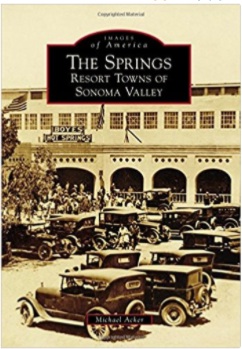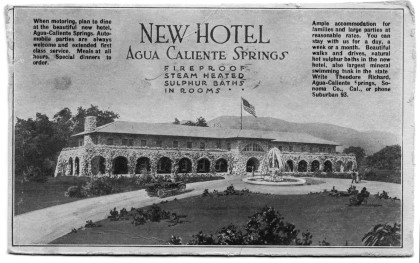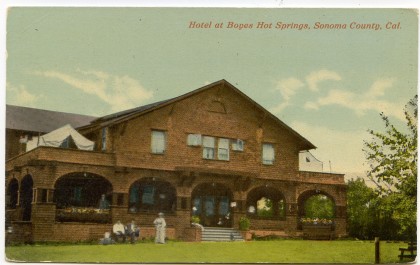The Springs: Resort Towns of Sonoma Valley
 By Michael Acker — The original Miwok inhabitants of Sonoma Valley called their village Wukiliwa, which combines the words in their language for fire and water. This useful name was adopted by the Spanish/Mexican colonizers, translated as Agua Caliente.
By Michael Acker — The original Miwok inhabitants of Sonoma Valley called their village Wukiliwa, which combines the words in their language for fire and water. This useful name was adopted by the Spanish/Mexican colonizers, translated as Agua Caliente.
In 1836 Ignacio Pacheco, a sergeant in the Mexican Army, was granted the Rancho Agua Caliente by the government of Mexico. He deemed it “unfit for agriculture” and traded it back for land in what became Marin County. He is believed to be the first person to plant grapes there and lent his name to the part of Novato that is now called Ignacio.
European settlement of what has come to be known as the Springs* area of Sonoma Valley truly began in July 1840 when Lazaro Piña was granted the 50,000 acre Rancho. He built an adobe house finished with wood and was establishing his homestead when war broke out with the United States and he was drafted into the Mexican Army.
After Pina died in the U.S. invasion of Mexico in 1846, his heirs were not able to defend their title to the land in U.S. courts. In the years 1860-1880, parts of the Rancho were claimed by Joseph Hooker who became a noted Army general in the Civil War, Mariano Vallejo, M. K. Cady, and Thaddeus M. Leavenworth, among others.
In 1846 Vallejo deeded 1,000 acres of his portion of the Rancho to Andrew Hoeppner, a music master, in exchange for piano lessons for Vallejo’s children. Heoppner became the first person to commercially develop the hot springs. In 1847 he advertised in the Daily Alta California Newspaper (San Francisco) his Annenthal warm springs with the line “No More Rheumatism!”
Thaddeus M. Leavenworth came to California in 1847 with Stevenson’s Regiment of New York Volunteers, raised to fight in the Mexican War. (The Regiment’s expressed purpose was to provide permanent settlers for California). During his tumultuous and controversial tenure as alcalde of San Francisco, (as the head executive was known under Mexican rule), in the years 1848-1849, he gained a reputation for less than honest dealings in real estate.
His welcome in the city by the bay worn out, he moved to Sonoma Valley, looking, quite literally, for greener fields. Sometime in 1849 he acquired 320 acres in Sonoma Valley, a parcel covering what is now know as Agua Caliente, Fetters Hot Springs, Boyes Hot Springs, and part of Maxwell Farm.
A few years later, the title to this parcel became disputed. The dispute went to the United States Land Commission, set up after the Mexican War to decide ownership of former Mexican land grants. Leavenworth’s claim on the 320 acres of the Rancho Agua Caliente also claimed by M.G. Vallejo, was approved in 1860. According to local historian Robert Parmelee, “Apparently Leavenworth had better appearing forged documents than his adversary.”
In 1882 Captain Henry E. Boyes, a retired officer of the Indian Navy man, arrived in Sonoma Valley with his wife Antoinette. Looking for a genteel and healthful retreat, they were persuaded by Leavenworth to buy 110 boggy acres of his 320-acre tract, which happened to include a hot spring. Unfortunately, the naïve Boyes had fallen prey to a scheme that Leavenworth had perfected in San Francisco. The title to the land Captain Boyes paid for was already held by someone else. Only after years in the courts, Boyes gained clear title to the land.

Wiser but undeterred, Boyes and his business partners set about trying to capitalize on that asset. Their first attempt, the Agua Rica Hot Sulphur Springs Association, was incorporated in 1895, but did not attract investors. In 1901, they tried again with the Boyes Hot Springs corporation, and were successful enough to build guest cottages, a club house, a hotel and a swimming pool 75’ by 100’. (This became the Boyes Bath House).
Apparently, the existence of the hot water was forgotten over time. An 1889 article in the Sonoma Index Tribune states that “It may not be generally known, but it is nevertheless a fact that there exists in the valley a hot mineral spring, the curative powers of which are remarkable. This spring, the waters of which are now running to waste, is located on Agua Rica Farm, two miles northwest of Sonoma, the property of Mr. and Mrs. Boyes.” {This statement by the Index Tribune Newspaper is curious as the Agua Caliente Springs was advertising in the paper at this time}.
Boyes sold his interest in the resort in 1902 and built a grand house, which he called El Mirador, on a nearby knoll. Mr. and Mrs. Boyes left the Valley for San Diego in 1913.
Boyes Springs continued to prosper. A post office was established in 1911.
As early as 1909 residential subdivision were platted and building lots were sold. By 1927 there were 22 subdivision and additions in the Springs, with names such as Boyes Springs Park, Woodleaf Park, Fetters Springs Terrace, and Agua Caliente. In 1918 a small lot in Boyes Springs Park Subdivision “A” was sold for “$10 gold.” The deed contained covenants that prevented the new owner from establishing a gambling casino, saloon, or other “ house of amusement.”
The bathhouse was enlarged under the management of R.G. Lichtenburg and Robert Parramore to become the premier destination of Sonoma Valley for decades. Generations of Sonomans learned to swim in its huge pool.
Much of Boyes Springs, including Boyes’ resort, was destroyed in September of 1923 by a disastrous fire that spread from the north. The next day the Index Tribune headline read, “Boyes Springs, Famous Summer Resort, Leveled by Flames.” Indicating the resiliency of the people, a sub-headline read, “Hot Springs Hotel will be Rebuilt.” Among the buildings listed as destroyed were the cottages of J. W. Minges. Minges, the “mayor” of Boyes Springs was quoted as saying “Boyes will rise from the ashes again! Fire cannot rob us of our mineral springs, our climate, and the whole-souled people who abide here, no siree!”
In 1927, on the site of Boyes’ original hotel, a new hotel was built, which became the Sonoma Mission Inn. Its fortunes were up and down. It was thriving through World War Two, when it became a rest haven for members of the armed services. After the war it became a residential hotel for a time, going through several owners. Currently, the Sonoma Mission Inn is managed by the Fairmont Corporation, and is a premier wine country resort.
Fetters Hot Springs
The success of Henry and Antoinette Boyes proved to be an example to others. In 1907, a couple from Pittsburg by way of San Francisco by the name of George and Emma Fetters, bought an old ranch just a mile north or the Boyes’ property. The next year they opened Fetters Hot Springs Resort. Soon after, they leased their resort to Morris Levy, who renamed it Eleda Hot Springs. The Fetters took over operation again in 1911.

Agua Caliente Springs
An article in an 1889 issue of the Sonoma Index Tribune read, in part, “the famous health-giving springs, delightful location and basalt block interests of this progressive little village is destined at no distant day to make it a place of considerable importance. The town was laid out a little over a year ago by M.K. Cady, one of Sonoma Valley’s most energetic and public-spirited men. The railroad runs through the place which boasts of an express office, post office, schoolhouse, hotel general merchandising store, butcher shop, and a blacksmiths shop. During the spring and summer months the Agua Caliente Springs Hotel is crowded with health and pleasure seekers who come to lave in its health restoring water and bask in never failing sunshine and balmy breezes. An Episcopal Church will be erected a Agua Caliente this summer.”
The Agua Caliente Hotel, under the management of M.K. Cady, was opened in the summer of 1885. In 1886 the Index Tribune reported that “The Agua Caliente Hotel, Having been enlarged and refurbished, is now one of the most elegant and attractive summer and winter resorts on the coast.” In 1887 the Index Tribune informed us that “The new swimming baths at the Agua Caliente Warm Springs are completed and now open to the public. They are the largest and best appointed mineral baths in the state. The water of these springs are of delightful temperature for bathing and their curative properties are highly endorsed by our leading physicians.”
This was all well before Boyes commercialized his springs, though the couple was living in the valley at that time. The “new” hotel, the stone edifice that exits today, was built in 1916.
In August of 1886, the Agua Caliente post office was established, the first one between Sonoma and Glen Ellen. Mrs. C.F. Badger was appointed Post-mistress and lock boxes were $0.15 per month.
El Verano
El Verano, as a place name, is older than either Boyes Springs or Fetters, and both of the later were once considered to be parts of El Verano.
El Verano was established in 1887 as a real estate venture, by George H. Maxwell and partners. Elaborate maps of the development were published and well-known photographer Carlton Watkins was hired to make a series of photographs to promote the town. Maxwell soon went broke, however, and the area languished amidst a series of lawsuits brought by unhappy investors.
But the natural beauty of the site continued to be a draw, and several of the area’s most prominent resorts were established in El Verano, Among them Parente’s, Paul’s, El Verano Villa, and the Bellevue Hotel. El Verano also had an imposing railroad station which was demolished in the 1980s and replaced by the offices of the Valley of the Moon Water District.
The El Verano post office was founded in the 1890s and today remains the heart of the community. The El Verano Inn, which began life as Mullens Store in 1887, has been recently, lovingly restored and still functions as a tavern and music venue.
AUTHOR NOTE: * Some controversy has arisen about the name. Some people feel it robs the towns of their individuality. It has actually been in use as a collective term since the 1930s, at least. Whenever it is necessary for clarity, I always use the separate names. I live in the Springs, not Sonoma. Where, exactly? In Boyes Hot Springs.
Excerpted from “The Springs: Resort Towns of Sonoma Valley,” by Michael Acker. Available at Readers’ Books in Sonoma, at other bookstores, and can be ordered online. Arcadia Publishing. ISBN-10: 1467124303. ISBN-13: 978-1467124300
About the author
Michael Acker has been a resident of Sonoma Valley since 1998. A local artist and historian, Michael works at the Sonoma Community Center, is Past President of the Sonoma Valley Grange, and is an activist in the Springs Community Alliance. He holds an MFA in Sculpture from San Francisco State University.




